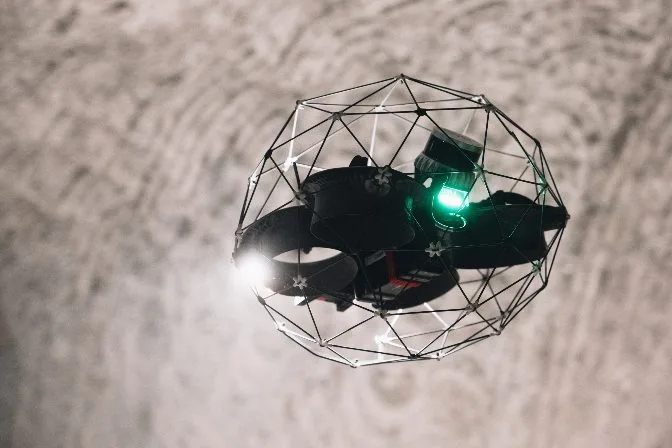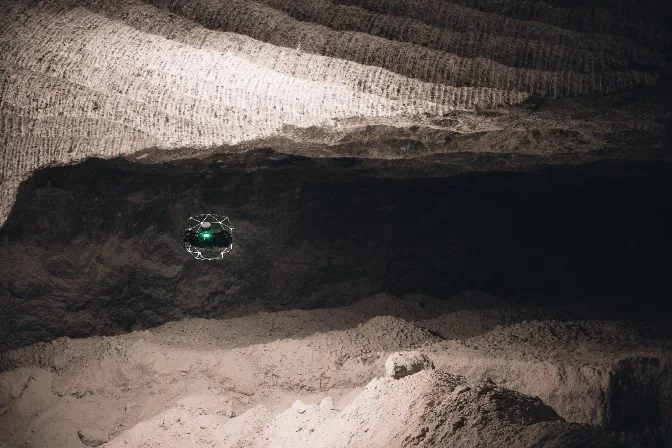A Guide to How Drones are Used for Inspections
A Comprehensive Guide to Drone Inspections Across Industries
Today, drone inspections have become a standard practice in almost every industry that involves maintenance procedures requiring visual checks. By using drones to collect visual data, inspectors can avoid hazardous situations, enhancing both safety and efficiency.
Drone inspections are revolutionizing traditional inspection methods, enabling faster data collection and eliminating risky manual steps. For instance, inspecting a cell tower manually may involve climbing several stories, whereas checking an industrial boiler might require ascending fifty feet or more using scaffolding. Drones are transforming these processes entirely.
 Indoor inspection drone, the Elios 3
Indoor inspection drone, the Elios 3
In this guide, we'll explore the best drones for inspections, the goals of aerial data collection, and the advantages of adopting drone inspections. We'll also examine the industries utilizing drone assessments and touch on the diverse roles within the drone industry.
Top Inspection Drones for Every Job
Choosing the right inspection drone depends on the task at hand. The market offers hundreds of drones with unique features tailored to specific industries or applications. For instance, for large-scale land surveys, a fixed-wing drone with a long flight time is ideal for optimizing efficiency. In windy, low-altitude environments, a maneuverable multi-rotor drone might be more suitable due to its agility and resistance to unpredictable winds.
When working in confined spaces, selecting a robust drone that can withstand challenging conditions—such as dust, poor visibility, and minor collisions—is essential. The Elios 3, a specialized inspection drone, fits this requirement perfectly. Equipped with a LiDAR sensor and a 4K camera, it excels in rugged environments like cement silos and underground mines.
What is a Visual Inspection and Why Does It Matter?
A visual inspection involves thoroughly examining every part of an asset with the naked eye. Often, drones act as inspectors' eyes, collecting visual data that is later analyzed in detail. While some analysis occurs on-site, the bulk of the inspection happens afterward by reviewing the collected data.
Consider inspecting a cell tower. Traditionally, an inspector climbs the structure, checking for maintenance needs. Similarly, internal inspections of boilers or pressure vessels require climbing with ropes or scaffolding. Visual inspections are vital for asset management, as replacing small parts like rivets is far cheaper than building a new tower. Beyond cost-saving, these inspections ensure safety by addressing potential hazards like pressure vessel explosions.
Not All Drone Inspections Are Visual
Although most drone inspections are visual, drones can be equipped with specialized sensors for non-visual inspections. Any sensor that fits on a UAV can be used for inspections. For instance, drones in agriculture use multispectral sensors to capture crop images in distinct spectral bands. In HVAC inspections, thermal cameras identify heat leaks in buildings.
Specialized drones can carry multiple payloads to adapt to different environments. The Elios 3, for example, carries a RAD sensor for radiation detection, a LiDAR scanner for surveying, and an ultrasonic thickness payload for thickness measurements. These tools enable drones to inspect a variety of environments, showcasing their versatility.
Where Inspections Fit in the Maintenance Process
Before diving into specific drone applications, it's important to understand their role in the maintenance process. Whether dealing with a pressure vessel or a power line, the routine follows the same steps: inspect, repair (if necessary). Drones assist in the inspection phase by sending UAVs into dangerous scenarios like chimneys or cell phone towers, gathering visual data without risking human safety.

Even if maintenance is required, drones can't perform the work themselves. However, they reduce the frequency of scaffolding construction by up to 80-90%, cutting costs significantly. Additionally, drones decrease inspection-related downtime and liability insurance costs.
The Advantages of Drone Inspections
We've already seen how drone inspections enhance safety by keeping inspectors out of dangerous situations. They also bring substantial financial benefits.
How? First, remember that inspections precede maintenance. Often, inspections reveal no issues, with only 10-20% requiring maintenance. In such cases, drones could handle the entire inspection process, saving companies up to 80-90% in related expenses.
Building scaffolding is costly and time-consuming. Without drones, scaffolding is erected daily, causing significant downtime and revenue loss. Reducing personnel exposure to danger also lowers liability insurance premiums.
Drone inspections offer numerous advantages:
-
Reduced Risk. Inspectors are no longer exposed to hazardous conditions.
-
Savings on Temporary Structures. Avoiding scaffolding construction saves money.
-
Savings on Downtime. For assets like power plants, minimizing downtime translates to greater revenue.
-
Savings on Liability Insurance. Lowering risk exposure reduces insurance costs.
-
Improved Safety Through Increased Inspections. Regular inspections detect problems earlier, preventing larger issues.
-
Better Records. Drones provide detailed asset records, aiding future maintenance decisions.
Learn more about drones enhancing safety from this article in Bloomberg News.
Standards and Formal Inspection Bodies
Many industries with potentially hazardous assets conduct inspections not just for practical reasons but also due to legal requirements.
Inspection Standards
For assets like pressure vessels, boilers, and nuclear power plants, laws typically mandate adherence to specific standards during inspections. These standards are usually set by industry-focused associations like the American Petroleum Institute (API) or the American Society of Mechanical Engineers (ASME).
These organizations develop codes for designing, constructing, and inspecting specific assets, which are legally enforced worldwide.
Formal Inspection Bodies
For dangerous assets, laws often require the presence of a representative from a formal inspection body. These entities provide certified inspectors who verify compliance with mandated standards. Inspectors undergo rigorous training and certification from relevant organizations.
While standards associations may have general guidelines, formal inspection bodies often impose stricter standards. Certified inspectors must exercise judgment in the field, determining whether a tool like a drone camera can replace the naked eye.
Are Drones Allowed in Formal Inspections?
Most standards organizations remain solution-neutral, neither endorsing specific tools nor companies. Instead, inspectors make individual judgments in the field.
However, formal inspection bodies approach drones cautiously. Organizations like Bureau Veritas and the American Bureau of Shipping have certified drone-collected inspection data, validating the data rather than the tool itself.
Drone Inspections Across Industries
In the following sections, we'll explore industries leveraging drone inspections.
Each section describes how drones are used, the benefits, the assets inspected, and case studies. This list is a great starting point for exploring job opportunities in the drone industry.
Drone inspections can be categorized into indoor and outdoor based on the environment. Indoor inspections in confined spaces demand different drones and capabilities compared to outdoor inspections.
Industry List
-
Agriculture
-
Chemicals
-
Construction
-
Infrastructure & Utilities
-
Insurance
-
Power Generation
-
Mining
-
Oil & Gas
-
Public Safety
-
Other Drone Inspection Scenarios
Agriculture Drone Inspections
Drone inspections in agriculture are gaining traction. Farmers use drones to monitor crops and livestock, and to create 3D maps of farmland for better irrigation management.
Drones provide quick insights into crop health, enabling early intervention. Data collected helps optimize crop yield and reduce labor-intensive inspections. Regular drone flights also create historical records for future comparisons.
Assets Monitored
-
Crops
-
Irrigation systems
-
Land conditions
-
Soil health
-
Livestock
Chemical Industry Drone Inspections
Chemical facilities require precise maintenance to prevent leaks and environmental hazards. Drones reduce exposure to harmful substances and eliminate scaffolding costs.
Assets Inspected
-
Pipe racks
-
Cables
-
Conduits
-
Tanks
-
Heat exchangers
Construction Drone Inspections
Construction companies use drones to monitor project progress. Drones enable rapid aerial data collection, improving accuracy and safety.
Assets Inspected
-
Construction sites
-
Stockpiles
-
Safety conditions
Infrastructure & Utilities Drone Inspections
Drone inspections assess utilities like bridges and power lines. Benefits include fast data collection and reduced risk.
Assets Inspected
-
Utility towers
-
Bridges
Power Generation Drone Inspections
Power plants use drones to inspect boilers, chimneys, and turbines. Drones enhance safety and reduce costs.
Assets Inspected
-
Boilers
-
Chimneys
Mining Drone Inspections
Mining drones inspect stopes and conveyor belts, improving safety and efficiency.
Assets Inspected
-
Stopes
-
Conveyors
Oil & Gas Drone Inspections
Drones inspect storage tanks and offshore rigs, reducing risk and saving time.
Assets Inspected
-
Storage tanks
-
Rigs
Public Safety Drone Inspections
Public safety drones assist in search-and-rescue operations and crime scene investigations.
Applications
-
Search-and-rescue missions
-
Crime scene analysis
Maritime Drone Inspections
Maritime drones inspect ballast tanks and hulls, improving safety and efficiency.
Applications
-
Ballast tank inspections
-
Hull surveys
Sewer & Water Treatment Drone Inspections
Specialized sewer drones inspect pipelines and tanks, improving safety and data collection.
Assets Inspected
-
Pipelines
-
Tanks
The Future of Inspection Drones
As industries increasingly adopt drones for safer, faster, and more reliable data collection, the growth of drone inspections shows no signs of slowing. This dynamic sector evolves rapidly to meet complex industry demands. While this guide highlights several industries, countless unique drone applications exist beyond the scope of this discussion. With such adaptable technology, the possibilities are virtually limitless!
Yellow Green Base Band Chip,Yellow-Green Base Belt,Base Belt,Yellow-Green Film Base Tape
Jiangsu Bailite Transmission Technology Co., Ltd , https://www.zsindustrialbelt.com
